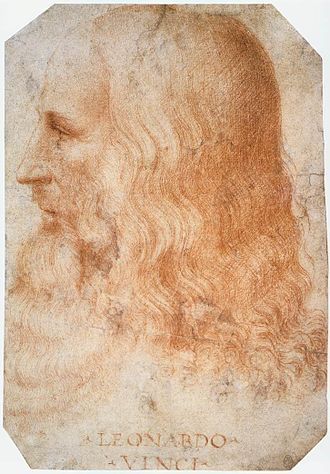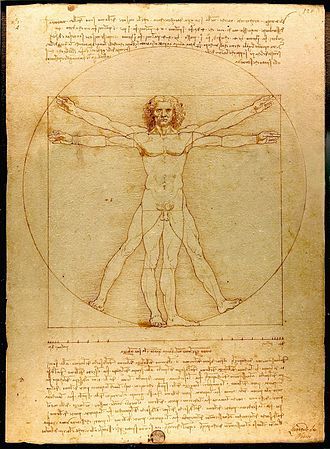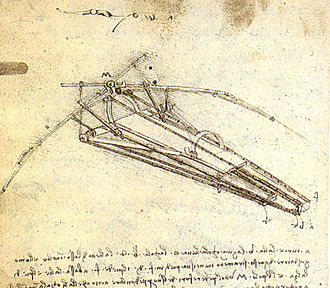Leonardo Da Vinci Art Can Impact Social Justice Yahoo Answers
What historical figures are held in college esteem or given more than credit for their accomplishments than they deserve?: originally appeared on Quora: The all-time answer to any question. Ask a question, get a great respond. Larn from experts and access insider cognition. You can follow Quora on Twitter, Facebook, and Google+.

Reply by Tim O'Neill, 1000.A. in Medieval Literature and has studied most aspects of the period for many years.

Leonardo da Vinci
While there is no doubtfulness that Leonardo (he is not referred to as "Da Vinci" despite what a certain stupid novel may say) was a remarkable artist, he is often credited with influence and significance in other fields that he simply did not have. We can regularly read that he was a "scientist" and that he devised inventions that "changed the world". We tin read claims that his anatomical drawings were "highly influential" and that "past combining anatomical studies with his art (he) helped to invent modern anatomy studies". We are also regularly told that he was "a man earlier his time" and that he "was the first person to design a flying machine, centuries before the Wright Brothers".
These statements are essentially nonsense.
"Scientist?"
Strictly speaking, it is anachronistic to refer to anyone as a "scientist" earlier 1834, which is when the modern formulation of a scientist had develped to the point where someone, William Whewell to be precise, felt the demand to propose a new word to describe these people. Prior to Leonardo's fourth dimension there were certainly natural philosophers who we sometimes refer to as early "scientists" who practiced a course of proto-scientific analysis of the real globe via observation, induction and rational analysis. By the after Center Ages this process was becoming more precise, and used mathematics as a language for the analysis and measurement of the physical world for the first fourth dimension too as beginning to lay the foundations of empiricism. By the Seventeenth Century this had developed to the point where actual science in the modern sense was beginning to exist practised, though not with the total rigor of later periods.
So, in a sense, in that location were "scientists" in Leonardo's time. The problem is, he wasn't 1 of them. Leonardo did non take part in the discussions of his day on physics, optics, mechanics or astronomy mainly because, as an artisan, he did not have the instruction to do and so. He had no training in mathematics and none of the pedagogy in logic and anterior reasoning that lay behind these proto-scientific conversations. As a result, he was non part of them at all.
When well-nigh people talk nearly him beingness a "scientist" they are thinking of his engineering and, more than ofttimes, of his sketches of some highly speculative machines. In the modern world, "science" and "technology" are intimately linked, with 1 ordinarily leading directly to the other in most cases. Or engineering aids the pursuit of science. Only this link did not exist in Leonardo's time.
He was regarded as an artisan, though a highly skilled and creative 1. As such he could be deputed to paint a portrait in oils, create an equestrian statue bandage in bronze, produce a fresco, pattern a siege engine or drain a swamp. These are the kinds and variety of things that artisans had been expected to practice throughout the Center Ages and Leonardo was very much a part of that tradition. He wasn't even an "artist" in the modern (mainly Nineteenth Century) romantic sense. He was an artisan who could plough his hands to a range of applied creative projects equally patrons required. Simply he was not a "scientist".
"Anatomist"?

Leonardo's beautifully detailed and complicated anatomical drawings are well known to the point where they are iconic images. This has led to the idea that he revolutionized beefcake, was the starting time to produce such images and was a highly influential anatomist. These are all myths. Leonardo's drawings had null influence on anatomy, because they were not published until centuries after his death. Like well-nigh of his sketches and notebook material, none of his anatomical drawings saw the low-cal of day until they were reproduced in print in the Nineteenth Century -- they were unknown in his time.
The uniqueness of his drawings is as well regularly overstated. Man dissection for the report of anatomy had been revived in the later Centre Ages, after centuries of neglect due to Greco-Roman taboos about corpses stifled such study in the aboriginal world. Anatomical drawings based on dissections start announced in the Fourteenth Century and increased in skill and sophistication from that point. As artists became increasingly interested in anatomical realism, the study of these drawings and the use of dissections to empathize musculature and how the body is made upward became part of the study of a young painter, and Leonardo would have learned this from his master Verrocchio. Merely like all artists of his time who used anatomy, he and his master were drawing on and working inside an established tradition of anatomical drawing -- Leonardo did non invent it.
If anyone tin be credited with revolutionising anatomical drawing in this period, it's Jan van Calcar, the artist who produced the superbly detailed woodcuts that accompanied Andreas Vesalius' De humani corporis (1543). While not as fine artistically as Leonardo's, they were far more authentic anatomically and, dissimilar Leonardo'due south private sketches, were widely published and highly influential on all the anatomical studies that came later.
"Inventor"?
The idea that Leonardo was a genius who was centuries before his time and invented things that inverse the world forever as part of the glorious Renaissance is the standard story that is taught to school children. Leonardo was certainly highly creative and did come up up with a few theoretical designs that show a highly inventive intellect at work. Unfortunately, few of them were more sketches, or even idle doodles, and almost none of them saw the light of day. Far from being influential they, similar his anatomical drawings, lay unknown in archives until the Nineteenth Century.

He is credited with inventing things that were "centuries before their fourth dimension" and being the first to conceive of such "modern" ideas equally the parachute, the helicopter and a flying machine. None of these claims are truthful. Sketches from a century earlier Leonardo's nascence show people were already familiar with the concept of a parachute - at least enough to draw an impractical-looking i in use. The helicopter-similar motorcar he sketched would never have worked, but the concept of rotating blades providing lift was already well-known enough for the it to be the basis for a tardily Medieval children'due south toy where a string-pulled rotor could be fabricated to fly from a hand-held stick. And far from being Leonardo's innovation, people had not only been thinking or fifty-fifty designing flying machines long earlier Leonardo, only they had actually done what he never did: built and flew them. Ailmer of Malmsbury, a Medieval Benedictine monk, built and flew a working glider in the mid-Eleventh Century - centuries earlier Leonardo was even born.
Conclusion
Leonardo, as a highly skilled and artistic artisan in a long tradition of artist-engineers, produced some beautiful paintings and displayed a vast curiosity about the world through his sketches and his tinkering with ideas. Merely his status as a "scientist, anatomist and inventor" who was centuries ahead of his fourth dimension is wildly overstated and is largely due to common misunderstandings most what these titles mean and a general ignorance about his historical context and the Medieval traditions and precursors who came before him.
More questions on Quora:
Source: https://www.huffpost.com/entry/debunking-the-myths-of-le_b_7153104
0 Response to "Leonardo Da Vinci Art Can Impact Social Justice Yahoo Answers"
Post a Comment